p.43
p.52
p.61
p.66
p.72
p.79
p.85
p.91
p.99
Cavitation its Use and Mathematical Modelling
Abstract:
The problem of cavitation is highly discussed and published phenomenon not only in a negative sense, but in the positive use also. In hydraulic systems the cavitation is undesirable phenomena specific by cavitation wear and noise. These systems operate at ever-increasing operating conditions (pressure and flow). For this reason, this phenomenon occurs in many technical applications. The problem cavitation is very large, so it is necessary to define the area of scientific interest. Currently, there is an increasing interest in the fields of mathematical and experimental research in hydraulic elements and systems engineering practice. The paper is focused on modelling of shape of cavitation area and influence of air content primarily on the simple geometry of plane nozzle, where the water is flowing.
Info:
Periodical:
Pages:
72-78
Citation:
Online since:
September 2014
Authors:
Keywords:
Price:
Сopyright:
© 2014 Trans Tech Publications Ltd. All Rights Reserved
Share:
Citation:


